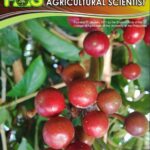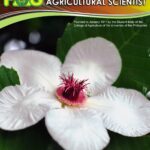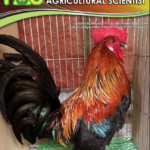Vol. 100, No. 3 (Sep 2017)
Miracle fruit [Synsepalum dulcificum (Schum & Thonne) Daniell] is a novel fruit whose unique characteristic is to modify the taste bud and to make any sour-tasting solids or liquids sweet even without sugar. The taste-modifying effect is due to miraculin, a molecule which binds the sweet taste receptor in the tongue’s epithelium plasma membrane. The effect lasts for about one hour. Common knowledge is that the fruit is red until a yellow-fruited strain developed out of around 23 000 plants grown in a miracle fruit farm in Calauan, Laguna, Philippines. The yellow-fruited strain has a typical growth pattern similar to that of the red-fruited strains. The fruits are of medium size, ellipsoid, and seldom crack with sudden surge in soil moisture due to heavy rainfall. Miracle fruit has potential ornamental value and is suitable for wine processing.
{Photographs courtesy of Dr. Domingo E. Angeles, Institute of Crop Science, College of Agriculture and Food Science, University of the Philippines Los Baños, College, Laguna, Philippines}
Categories
Articles
The Effect of Chitosan-Based Nanocomposite Coating on the Postharvest Life of Papaya (Carica papaya L.) Fruits
Dianne Krizzia A. Allanigue, Veronica C. Sabularse, Hidelisa P. Hernandez, and Edralina P. Serrano
Nanochitosan, which was prepared by ionotropic gelation of chitosan and polyphosphate ions, had an average particle size of 112 nm. The nanochitosan was incorporated in formulations for chitosan-based nanocomposite (Ch-NCh) films and coatings. The 80% nanochitosan (v/v) containing film (Ch80NCh + Add) was the most compact and thinnest, followed by the 40% nanochitosan (v/v) containing film (Ch40NCh + Add) and the 1% chitosan-plus-additives film (Ch + Add) which was highly porous and the thickest. The capability of the coating formulations to extend the postharvest life of cv. Sinta papaya fruits, which were stored at 14.6 °C and 79% relative humidity, was evaluated. Control (uncoated) and...
Nanochitosan, which was prepared by ionotropic gelation of chitosan and polyphosphate ions, had an average particle size of 112 nm. The nanochitosan was incorporated in formulations for chitosan-based nanocomposite (Ch-NCh) films and coatings. The 80% nanochitosan (v/v) containing film (Ch80NCh + Add) was the most compact and thinnest, followed by the 40% nanochitosan (v/v) containing film (Ch40NCh + Add) and the 1% chitosan-plus-additives film (Ch + Add) which was highly porous and the thick...
Aloe vera Gel and Sulfur Dioxide Fumigation Extend Postharvest Storage Life of Peach
Abdul Sattar Shah, Said Wahab, and Khandazi Fatima Khattak
Peach fruits cannot be stored for a desirable length of time due to chilling injury and the incidence of decay during cold storage. The effects of Aloe vera gel and sulfur dioxide fumigation on physicochemical contents, chilling injury, decay index, and sensory quality of peach fruits during cold storage were investigated. Fruits were harvested at physiological maturity and stored at 0 °C ± 1 °C and 90% ± 5% RH for 30 d. The results showed that the combination of Aloe vera gel and sulfur dioxide fumigation significantly affected moisture, total soluble solids (TSS), pH, acidity, sugar-acid ratio, reducing sugars, non-reducing sugars, vitamin C, firmness, chilling injury, decay index and s...
Peach fruits cannot be stored for a desirable length of time due to chilling injury and the incidence of decay during cold storage. The effects of Aloe vera gel and sulfur dioxide fumigation on physicochemical contents, chilling injury, decay index, and sensory quality of peach fruits during cold storage were investigated. Fruits were harvested at physiological maturity and stored at 0 °C ± 1 °C and 90% ± 5% RH for 30 d. The results showed that the combination of Aloe vera gel and sulfur diox...
Characterization of Yellow-Fruited and Red-Fruited Strains of Miracle Fruit [Synsepalum dulcificum (Schum & Thonne) Daniell]
Domingo E. Angeles, Kenji Nakamura, and Koji Yasuma
Five strains of miracle fruit consisting of the yellow strain and four red-fruited strains grown in Mabacan, Calauan, Laguna, Philippines were characterized. All strains showed similar growth patterns, flowering and fruiting periods, and stages of reaching maturity. The plant is evergreen, grows slowly, and reaches gestation period in 2.5 yr. It grows intermittently through a cyclical pattern of vegetative and reproductive periods. The yellow-fruited strain is unique, or one of its kind. Its flushes and fruit skin are light yellow. The leaves are acuminate with acute apex and acuminate base, glabrous, and cluster in the terminal of the shoots. The leaf margin is slightly undulating. Each ...
Five strains of miracle fruit consisting of the yellow strain and four red-fruited strains grown in Mabacan, Calauan, Laguna, Philippines were characterized. All strains showed similar growth patterns, flowering and fruiting periods, and stages of reaching maturity. The plant is evergreen, grows slowly, and reaches gestation period in 2.5 yr. It grows intermittently through a cyclical pattern of vegetative and reproductive periods. The yellow-fruited strain is unique, or one of its kind. Its ...
Physiological and Growth Responses of Begonia semperflorens to Different Growing Media
Monica Popescu and Gheorghe Cristian Popescu
Begonia plants are among the most popular ornamental plants that are very well suited for landscaping, flowerbeds, hanging baskets or container pots. Currently, in Romania, there has been an increasing demand to produce flowers for the landscaping market, and for the use of land in private and public gardens. Several organic and inorganic natural materials in different combinations were investigated for photosynthetic capacity, leaf area and flowering potential of Begonia semperflorens. The main objective of this study was to determine whether or not different growing media formulas are suitable for ornamental plant production with marketable value. Optimization of growing media formulas ...
Begonia plants are among the most popular ornamental plants that are very well suited for landscaping, flowerbeds, hanging baskets or container pots. Currently, in Romania, there has been an increasing demand to produce flowers for the landscaping market, and for the use of land in private and public gardens. Several organic and inorganic natural materials in different combinations were investigated for photosynthetic capacity, leaf area and flowering potential of Begonia semperflorens. The m...
Cadmium Accumulation and its Effects on Nutrient Uptake and Photosynthetic Performance in Cucumber (Cucumis sativus L.)
Hongyan Sun, Xiaoyun Wang, Li Shang, Zhaowei Zhou, and Rui Wang
The phytotoxicity of different concentrations (0, 10, 25, 50, 100 and 200 μM) of cadmium (Cd) on cucumber (Cucumis sativus L.) seedlings was studied. Cucumber growth was negatively affected by increasing Cd concentrations, and biomass decreased significantly at concentrations of more than 25 μM, while the total antioxidant capacity decreased in all tissues. Moreover, Cd was accumulated primarily in roots, and Cd concentration increased with increasing Cd concentrations in solution. Cd induced a decrease in the photosynthetic performance (i.e., net photosynthetic rate, stomatal conductance, and transpiration rate), while there was an increase in intercellular CO2 level at Cd concentrations...
The phytotoxicity of different concentrations (0, 10, 25, 50, 100 and 200 μM) of cadmium (Cd) on cucumber (Cucumis sativus L.) seedlings was studied. Cucumber growth was negatively affected by increasing Cd concentrations, and biomass decreased significantly at concentrations of more than 25 μM, while the total antioxidant capacity decreased in all tissues. Moreover, Cd was accumulated primarily in roots, and Cd concentration increased with increasing Cd concentrations in solution. Cd induced...


